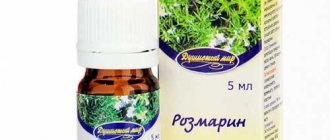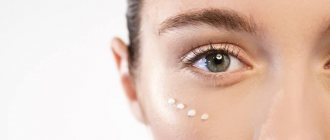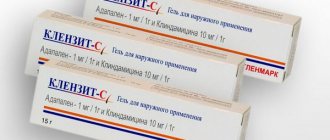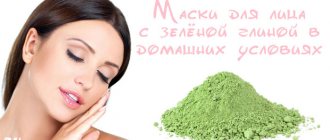Have you ever used white clay? I’m sure many have never even heard of such a remedy, but in vain! White clay for the face has many beneficial properties , for example, it can be used for skin elasticity, to tighten pores, to remove dead skin and even for acne. But this is not the main thing.
For example, I became acquainted with this remedy when I was looking for ways to treat spots that arose after acne. I must say, the clay coped with these with a bang.
Therefore, in today’s post, I decided to analyze all the main points related to white clay and share the tips for using it with you, dear readers!
Composition and properties
The composition of kaolin is very extensive and eliminates a wide range of problems and cosmetic defects.
Contains:
- Silicon – promotes exfoliation of dead epithelial particles;
- Magnesium – activates the synthesis of collagen, elastin and substances necessary to maintain skin turgor and moisture balance;
- Manganese - normalizes the production of sebum, removes particles of sebum, dead scales, and dirt from the pores;
- Aluminum – accelerates the restoration of tissues and cells, evens out skin tone.
Beneficial features:
- Giving the skin a healthy color;
- Soothing soreness, irritation and redness;
- Suppression of negative fungal activity;
- Dissolving sebaceous plugs;
- Making the skin matte;
- Formation of a clear oval face;
- Protection from the harmful effects of factors observed in places with unfavorable ecology - megacities, industrial cities;
- Removal of toxic substances from the skin layers;
- Possibility of use for sensitive and “capricious” dermis;
- Elimination of pain in inflamed areas.
Effect on skin
Thanks to such a simple but effective composition, white clay preparations for the face can have a therapeutic effect in the fight against acne:
- Cleanses the pores and surface of the skin, absorbing toxic substances and impurities.
- They dry it, removing excess fat, which is considered a provocateur of acne, and help narrow the pores.
- They have an antiseptic effect - they remove pathogenic microorganisms and fungal cells, as well as their waste products, from the surface of the skin.
- Stimulate cell regeneration, collagen synthesis, blood microcirculation, triggering the mechanism of renewal and rejuvenation of facial skin.
- Lighten dark spots and freckles, remove traces of inflammation.
- Anesthetizes inflamed skin areas.
- They have an anti-inflammatory effect.
- They help reduce scars after unsuccessful treatment or too intense acne rashes.
White clay against acne: how to use?
Despite the fact that white clay for the face against acne can be used in case of “difficult” skin, it is important to conduct an allergy test. Even such a gentle “product” sometimes causes intolerance to the components. You should apply a little mask on your wrist and wait 20 minutes. The absence of itching and redness indicates that the clay is tolerated normally.
It is acceptable to combine white clay with cosmetic powders of a different color, but it is important to choose a product based on your skin type.
Before starting the procedure, you need to cleanse your face, steam it with a herbal bath, and remove dead particles with a gentle scrub or gommage. Apply in a thick layer, avoiding the area around the eyes. The composition is removed after it dries. The final stage is rubbing the face with cosmetic ice to tighten the pores.
Masks are prepared with white clay that act directly on the rash, as well as mixtures that help additionally cope with excess oil or improve the condition of the sensitive dermis.
Acne masks
Based on home cosmetology recipes, you can prepare any white clay mask for acne. Mixing and application methods:
- Dilute a handful of white clay with bottled or filtered water. Apply before bedtime - the therapeutic effect will be maximum if you do not use decorative cosmetics afterwards;
- Prepare the mask according to the previous recipe. Enrich the mixture with 4 drops of lemon or orange essential oil. Useful for acne bacterial ecology;
- Squeeze the juice from the fleshy aloe leaf, after keeping it in the refrigerator for 4-5 days. Combine with clean water in equal proportions. Dilute kaolin with liquid so that you get a sour cream consistency. Lubricate your face with the mixture;
- Infuse a glass of boiling water with a tablespoon of chamomile flowers or marigold inflorescences. Dilute kaolin with a decoction, pour in 10 drops of salicylic acid. The mixture must be removed with the remaining liquid. Effective for severe inflammation;
- Mix mineral water and fresh lemon juice in a 1:1 ratio. Add white clay to the liquid until you get a paste. If there are no lemons in the house, the juice can be replaced with apple cider vinegar;
- Dilute the powder with natural liquid yogurt or kefir. Proportions are equal;
- Mix the main ingredient with boric alcohol. Lubricate rashes and ulcers locally. Keep the product on the affected areas until the morning;
- In a bowl, combine a tablespoon of kaolin and baby talcum powder. Dilute with the same amount of slightly warmed milk;
- Mix 25 ml of pharmacy calendula tincture with 10 drops of lemon juice. Dilute 3 tablespoons of white clay with the resulting liquid and stir. Rinse off the mixture with warm water;
- Dilute clay powder with natural grape juice. You should get a thick mass. Melt a teaspoon of honey and mix into the base. The mask is indicated for removing subcutaneous acne.
Masks for oily skin
Those with oily dermis not only have to deal with acne, but also constantly eliminate excessive shine and greasiness. The following masks help in this war:
- Pour 60 g of powder into a faience bowl. Dilute with a mixture of highly purified water and fresh lemon. Add 2 drops each of geranium and lavender essential essence. It is important to apply the composition in a dense layer;
- Squeeze juice from 2-3 tomatoes. Dilute kaolin with the resulting liquid and apply the mixture to the skin of the face;
- Combine a tablespoon of clay and a teaspoon of vodka. To obtain the required consistency, add boiled water. During preparation, you should not use strong alcohol - it dries the skin excessively, which in turn provokes increased activity of the sebaceous glands and the appearance of new acne elements;
- Mix a handful of kaolin with chicken protein. Dilute the mixture with kefir to a liquid state. Lubricate your face, avoiding the eye area.
Masks for sensitive skin
For sensitive skin combined with acne, you can prepare the aloe mask described above by replacing water with milk at room temperature. The following masks are also effective:
- Brew 2 tablespoons of chamomile inflorescences in 100 ml of water;
- Combine 15 ml of infusion and 15 g of clay powder;
- Spread the thick mixture evenly over the entire face;
- It is important to remove remnants of the mask with warm water.
Application of kaolin for facial skin
White clay products for the face are prepared and used taking into account a few simple rules. Compliance with them is necessary to preserve the beneficial properties of kaolin and obtain the maximum possible effect without harming the skin.
Here are a few rules:
- Kaolin and products based on it must not be diluted or mixed in metal containers. Clay components can react with metal and lose their beneficial properties.
- To prepare masks, do not use hot water or boiling water; contact with hot water spoils the structure of the substance and reduces the activity of its active components.
- The skin around the eyes and lips is too thin and dry, so the clay mixture should not be applied to these areas.
- White clay face masks are applied to the skin immediately after preparation.
- Do not allow the clay to dry completely on your face; this rule is especially important for dry and sensitive skin. Usually the mask is left on the face for no more than 20 minutes.
- The clay mask is washed off with water at room temperature without using cleansers.
- A white clay mask for acne is applied to a face that has been cleansed and steamed with herbal decoctions. You can use a decoction or infusion of chamomile or calendula.
- After removing the mask, the skin must be moisturized. To do this, you can use your favorite moisturizing or nourishing products.
- High-quality white clay should have a homogeneous composition without lumps or inclusions.
Kaolin is absolutely safe, but it is not used to treat open wounds, in addition, the product can aggravate skin irritation due to its abrasive and drying properties.
Kaolin retains heat well, so masks with it are not used at elevated body temperatures and exacerbation of cardiovascular diseases.
White clay for post-acne - application and effectiveness
The whitening effect that white clay has allows it to be used to lighten acne marks, smooth out scars and scars.
White clay for acne spots is effective in the following mask:
- Peel the cucumber;
- Pass through a blender and squeeze out the juice using gauze;
- Mix the liquid with the juice of half a lemon;
- Carefully add clay to form a thick mass;
- Distribute over the skin of the face;
- Wash after 25 minutes.
Also, to reduce pigmentation and smooth out scars, you need to use the following recipes:
- Mix a tablespoon of clay with a teaspoon of liquid honey. Dilute the mixture with milk until creamy. Apply the composition to the areas where there are scars and marks;
- Dilute kaolin with orange juice. Use to remove acne;
- Mix a tablespoon of powder with water to form a paste. Add 4 drops of rosemary ether;
- Add a mixture of proteins and lemon juice to the powder to form a thick mass. Apply to areas where scars and marks are localized;
- Mix a teaspoon of bodyaga with a handful of kaolin. Dilute with water. The duration of the procedure is 10 minutes.
Mask application technology
For the use of masks to be effective, you must follow the following rules:
- Make masks at regular intervals. Choose a specific day - let it be an “evening of masks”.
- Do not let the mask dry out on your skin. This may make the problem worse.
- Do not use masks more than once a week.
- To remove the mask, you must first spray it with water.
- Remove the mask carefully. This is best done using a sponge or cotton pad soaked in warm water.
- Do not reuse clay.
- Dilute kaolin powder with warm, but not hot water. Otherwise, the beneficial qualities of white clay will be lost.
- To prepare kaolin masks, do not use iron utensils.
- To avoid drying out your skin too much, use cream after the mask.
Contraindications and harm
Kaolin is a component of natural origin, so in most cases its use is completely harmless. However, dermatologists and cosmetologists inform that there are situations in which white clay for post-acne and acne requires a careful approach:
- Increased body temperature;
- Tendency to allergic skin reactions;
- Excessive dryness of the skin - kaolin can be used, but with moisturizing components;
- Open wounds and injuries;
- Dermatological diseases in the acute stage.
For chronic diseases of the heart and blood vessels, it is important to obtain a doctor’s approval before starting treatment with white clay.
Useful properties of kaolin
- White clay is an excellent antiseptic.
- It has a drying effect on rashes on the face and body.
- White clay will help lighten freckles and acne.
- By activating the protective functions of cells, it accelerates skin regeneration.
- Kaolin normalizes the functioning of the sebaceous glands. To do this, you can make kaolin masks 1-2 times a week for oily skin. For combination skin – once a week, applying to problem areas.
- Effectively cleanses pores and copes with skin thickening. A beneficial property of kaolin is considered to be the dissolution of the upper layer of the dermis.
- It improves blood circulation. Due to its high heat capacity, white clay is used for heating.
- Kaolin helps relieve irritation and itching.
- This substance helps remove toxins and poisons from the blood and lymph.
It is worth noting that it can only be used for oily or combination skin. If you have thin, dry or sensitive skin, it is better to use it in combination with moisturizing ingredients, for example, light natural oils or sour cream.
Reviews from those who have tried it
White clay is a product in demand by adherents of eco-cosmetics. Its positive properties are actively discussed on forums and in communities dedicated to cosmetological problems. White clay for acne was also tested. Reviews in most cases belong to women who pay attention to the various stages of care.
In the posts you can find information about the effectiveness of kaolin in fighting acne scars. Also, users themselves recommend using clay as a remedy for acne and generally improving the condition of the skin. Many note rejuvenation of the dermis, a tightening effect, and a decrease in irritation. There are often recommendations to replace water with hydrosols of lavender, chamomile or rose. The properties of flower essences enhance the therapeutic effect of kaolin.
Recipes for acne and spots
The cosmetic product is easy to use at home, it is sold in any pharmacy and is inexpensive. A clay face mask for acne is prepared directly from the powder, diluted with water to a paste or with the addition of other beneficial ingredients. The components should be mixed in glass or ceramic containers. The composition is applied to cleansed, steamed facial skin with a soft sponge or brush. Leave for 10 minutes, then rinse with cool water; do not allow the product to dry out, this can cause irritation, redness, and itching.
Clay masks for acne and blemishes:
- Recipe for cleansing oily skin: 2 teaspoons of yellow clay, 3 tbsp. l. water, ½ tsp. lemon juice and aloe vera, the same amount of honey, beaten egg. The ingredients are thoroughly mixed and distributed over problem areas. This product helps remove excessive sebaceous shine, make the skin matte, smooth, and remove comedones.
- Anti-inflammatory clay mask for the face: 2–3 tablespoons of chamomile, celandine or sage decoction, 5 drops of tea tree oil and berry vinegar 9%, 2 tsp. yellow clay. The recipe must be used at least 3 times a week, the treatment helps get rid of purulent acne, acne spots, relieve redness and irritation.
- Clay mask against acne for deep cleansing, narrowing pores: you will need 1 teaspoon each of yellow and black clay, egg white, lemon juice and chopped parsley, 1 tsp. flower honey. The product pulls out black plugs, brightens the skin, and reduces the enlarged openings of the sebaceous glands. It is enough to apply the mask once a week; it can also be used to treat combination skin; matte appears in the T-zone, and the rest of the dermis becomes soft and acquires a healthy color.











